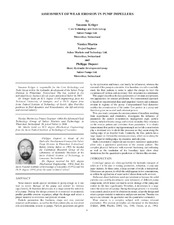| dc.description.abstract | Wear erosion needs special attention in pump design as it can lead to severe damage of the pump and restrict its lifetime significantly. It therefore determines to a large extent the selection of a pump. During the design process it is essential to accurately predict possible erosion in pumps, adapt the design and select a proper material to minimize and prevent erosion. Particle parameters like hardness, shape and size, material structure and hardness, as well as the flow pattern play an important role and determine erosion in pumps. Particle parameters are given by the application and hence, can hardly be influenced whereas the material of the pump is selectable. It is therefore crucial to carefully study the flow pattern in order to adapt the design to limit the occurrence of vortices and secondary flow structures to a minimum. This paper describes the key parameters of erosion and presents two approaches for erosion prediction. The Conventional approach is based on experimental data and empirical factors and estimates erosion in regions of the pump. Computational fluid dynamics enables the consideration of the entire flow pattern in a pump and therefore gives an overall and coherent picture. This case study compares the erosion pattern of impellers resulting from experiments and simulation, investigates the influence of parameters like particle concentration, impingement angle, particle velocity, turbulent kinetic energy, and vortices secondary flow structures on erosions pattern and correlates these parameters. It is clearly demonstrated that particle impingement angle and solids concentration play a dominant role in shock-like processes as they occur along the leading edge of an impeller blade. Contrarily, the flow pattern has a large impact on friction-like erosion processes, which occur along the blade, impeller trailing edge, tip clearance and side plate. Both conventional empirical and modern numerical approaches allow only a qualitative prediction of the erosion pattern. The complex physical behavior with material hardening and softening as well as the resolution of the boundary layer show clear limitations for the quantitative prediction of friction-like erosion. | en |


